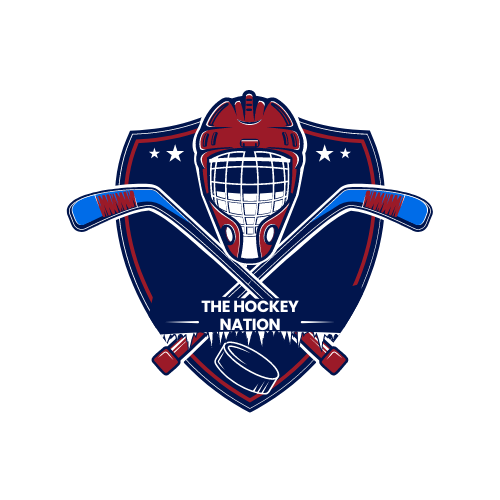When you hit the ice, your skates aren’t just gear – they’re like an extension of yourself. Picking the right hockey skates is all about finding that balance between performance and comfort, a dance between your blades and the ice that every player can relate to.
This guide makes buying hockey skates a breeze, mixing performance and comfort to help you score the perfect fit for your game. Get ready to explore the ins and outs of skate selection and glide onto the ice with confidence!
Understanding Hockey Skate Anatomy and Materials
1. Skate Components
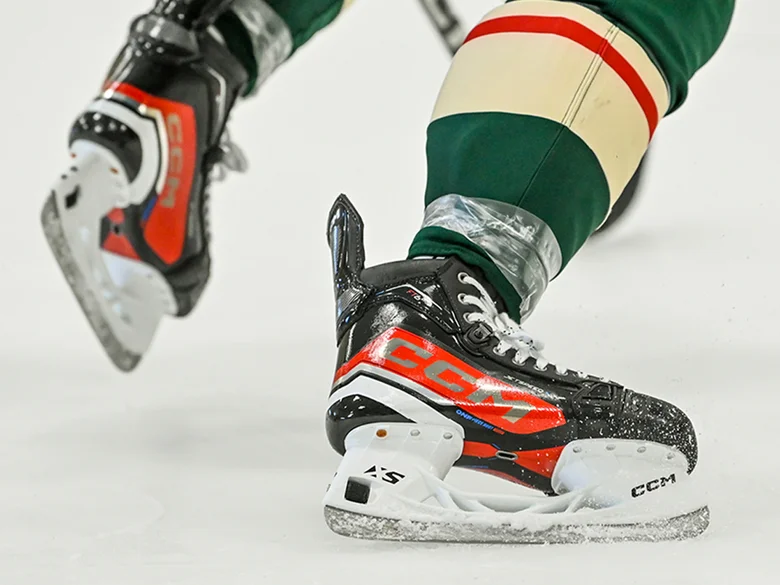
- Boot: The main part of the skate that wraps around your foot. It should be strong yet comfortable, blending resilience with grace.
- Blade: The part that glides on the ice, where the steel meets the road.
- Holder and Toe Cap: Important for protection and precision, these parts keep your feet safe and aid in sharp turns.
- Quarter Package: The skate’s structure from toe to heel, providing essential support and a secure fit.
- Tendon Guard: Protects the Achilles tendon, combining flexibility with safety for smooth movement.
- Tongue: Covers the front of your foot, balancing protection with comfort for each step.
- Liner: The inner part of the skate where comfort and function meet for top performance.
- Footbed: The support system inside, offering stability and comfort, a key player in comfort and control.
- Outsole: Links the boot to the blade, serving as the base for power transfer, connecting effort to movement.
Here’s the information organized in a table format.
| Component | Description | Function |
|---|---|---|
| Boot | Constructed from materials like leather, synthetic fibers, or thermoformable materials. | Provides support, protection, and comfort to the foot. |
| Blade | Made of high-quality steel, sometimes coated with materials like carbon for extra strength. | Allows for smooth gliding and sharp turns on the ice. |
| Holder | The part that connects the blade to the boot, often made of plastic or composite materials. | Ensures that the blade is securely attached to the boot and aids in energy transfer. |
| Toe Cap | Typically made of hard plastic or composite material. | Protects the toes from impacts and injuries. |
| Quarter Package | The main part of the skate boot, extending around the foot and ankle. | Provides structure and protection to the foot and ankle. |
| Tendon Guard | Extends from the heel up the back of the ankle. | Protects the Achilles tendon and supports ankle movement. |
| Tongue | A padded piece covering the front of the foot, made of materials like felt or foam. | Cushions the front of the foot, aiding in a comfortable and secure fit. |
| Liner | The inner surface of the boot, featuring strategically placed padding. | Enhances comfort, fit, and protection inside the skate. |
| Footbed | A removable insert inside the skate providing cushioning and support. | Offers arch support, enhances comfort, and improves edge control on the ice. |
| Outsole | The rigid bottom part of the boot where the holder is attached. | Transmits energy from foot to blade and provides a stable platform. |
This table format provides a clear overview of the different components of ice hockey skates, their descriptions, and functions.
2. Material Insights

Today’s hockey skates are impressive feats of engineering. With materials such as reinforced fiberglass and carbon-fiber polymers, they offer both durability and a lightweight feel, essential for quick decisions on the ice.
Skate Materials and Their Advantages
| Material | Characteristics | Advantages |
|---|---|---|
| Fiberglass | Lightweight and durable. | Offers a balance between flexibility and support. |
| Carbon Fiber | Extremely lightweight and strong. | Provides superior strength and stiffness, enhancing performance. |
| Thermoformable Material | Can be molded to the player’s foot. | Ensures a custom, snug fit for better control and comfort. |
| Steel (Blade) | Hard and durable. | Maintains sharpness longer, offering better performance on ice. |
This table format provides a clear overview of different materials used in ice hockey equipment, their characteristics, and advantages.
Hockey Skate Sizing and Fit
1. Determining the Right Size
Size matters significantly when it comes to skates. In the realm of hockey skates, they generally run 1–1.5 sizes smaller than your usual shoe size.
However, for women, this difference could be even greater, ranging from 2.5–3 sizes smaller. Getting the correct size is crucial as it serves as the initial step in establishing a seamless connection between you and your skates on the ice.
2. Achieving the Perfect Fit
A perfect fit is absolutely crucial when it comes to hockey skates. Picture yourself standing confidently in your skates – that quarter-inch of space in the heel is the magical touch that ensures comfort and performance.
Your toes should delicately brush against the toe cap, offering just the right amount of contact without any discomfort. And your heel? It should rest snugly, poised for any move you make on the ice.
Getting the sizing spot-on is key for top-notch performance and comfort in your hockey skates. To assist you in this process, here’s a handy table that will walk you through the steps to find that perfect fit:
Certainly! Here’s the information organized in a table format:
| Factor | Description | Tips for Perfect Fit |
|---|---|---|
| Skate Size vs. Shoe Size | Hockey skates generally run 1–1.5 sizes smaller than regular shoe sizes. For women, this could be 2.5–3 sizes smaller. | Measure your foot in inches and compare it to the skate manufacturer’s sizing chart. |
| Heel Space | Ideal heel space is about a quarter-inch when standing in skates. | Ensure your heel is snug in the boot to prevent sliding, which can impact skating efficiency. |
| Toe Position | Toes should slightly touch the toe cap but not be cramped. | Wiggle your toes to ensure there’s enough room for slight movement without excessive space. |
| Width Fitting | Skates come in various widths to accommodate different foot shapes. | Choose a width that complements the breadth of your foot, ensuring even pressure distribution. |
| Ankle Support | Essential for stability and control. The skate should firmly support your ankle without causing discomfort or restricting movement. | Ensure the skate provides adequate support without causing discomfort. |
Additional Considerations

Growing Feet: When selecting skates for children and teenagers, it is advisable to allow some room for growth while maintaining control and safety.
Custom Fitting: Certain premium skates offer heat molding to provide a personalized fit, enhancing both comfort and performance significantly.
Breaking In: New skates typically necessitate a break-in period. It is recommended to wear them around the house or during practice sessions prior to important games.
“A proper skate fitting is a blend of art and science,” emphasizes an experienced coach, underscoring the significance of achieving the right fit. “It is not solely about the size but also about how your foot interacts with the features of the skate.”
Common Mistakes to Avoid
Many new players make the mistake of choosing skates based solely on brand or appearance. However, experts agree that functionality should always take precedence over style.
For more on proper sizing, read about Choosing the Right Hockey Skate Hollow.
Understand more about Ice Hockey Skating Drills to improve your performance with well-fitted skates.
Skate Selection Based on Use and Skill Level
A. Frequency and Type of Use
Your choice of skates should align perfectly with the frequency and location of your play. If you find yourself gliding on the ice day in and day out, durability and comfort should be your top priorities.
On the other hand, if you’re more of a weekend warrior hitting the rinks, flexibility and easy break-in become key factors. And for the hardcore street hockey enthusiasts, skates designed to withstand the roughness of concrete are an absolute necessity.
Before making your final decision on which skates to go for, take a moment to think about how often you’ll be playing and the specific surfaces you’ll be skating on. This detailed guide will help you choose the perfect pair of skates tailored to your needs.
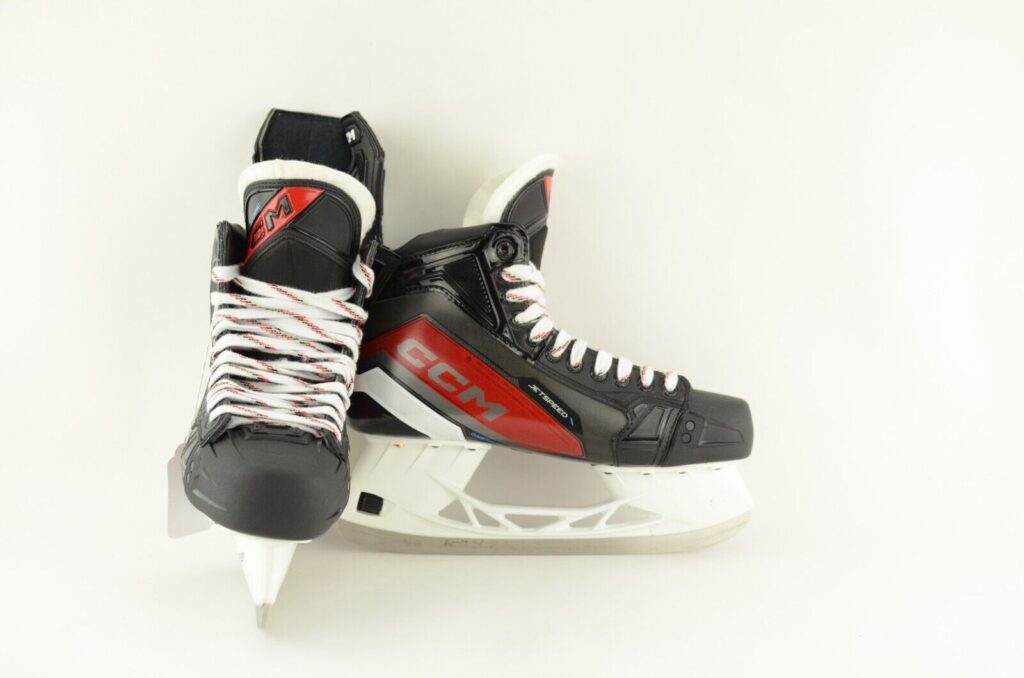
Certainly! Here’s the information organized in a table format:
| Usage Frequency | Playing Environment | Recommended Skate Features |
|---|---|---|
| Daily (Intensive) | Ice Rink | High durability, superior comfort, high performance |
| Weekly (Casual) | Ice Rink | Moderate durability, good comfort, flexibility |
| Occasional | Street Hockey | Enhanced abrasion resistance, flexibility, comfort |
| Recreational | Mixed (Ice & Street) | Versatility, moderate durability, comfort |
B. Skates for Different Skill Levels
Choosing skates is a personal journey that grows with your skill level. Beginners benefit from skates that provide support and forgiveness, while advanced players may prefer skates with precise responsiveness and agility.
Just remember, the perfect skates for you are the ones that match your place in your hockey journey. Your skill level is key in choosing your skates. This table helps make it easier:
Certainly! Here’s the information organized in a table format:
| Skill Level | Boot Stiffness | Blade Quality | Additional Features |
|---|---|---|---|
| Beginner | Low to Medium | Standard | Enhanced stability, comfort |
| Intermediate | Medium | High | Good balance, ankle support |
| Advanced | High | Premium | Lightweight, agility boost |
Technical Considerations and Personal Preferences
A. Skate Technology and Features
The newest skate tech has it all – heat-moldable boots for that perfect fit, lightweight but tough materials for speed and protection. Plus, features like adjustable blade positions to match your skating style for top performance!
B. Personalization for Playing Style
Your position on the ice and your playing style have a significant impact on the type of skates you should choose. For example, a forward may opt for skates that emphasize explosive speed and agility to maneuver quickly during plays.
On the other hand, a defenseman might prioritize skates that provide stability and protection, especially for blocking shots and maintaining balance in physical gameplay situations.
Ultimately, the key is to discover the perfect pair of skates that align with your unique approach and techniques on the ice.
Tailor your skates to your playing style and technical preferences with this table:
| Playing Position | Recommended Skate Features |
|---|---|
| Forward | Lightweight design, agility-focused blade, flexible boot |
| Defenseman | Reinforced protection, stability-focused design |
| Goaltender | Specialized boot for lateral movements, durable blade |
Purchase Considerations: In-Store vs. Online
1. Where to Buy Hockey Skates?
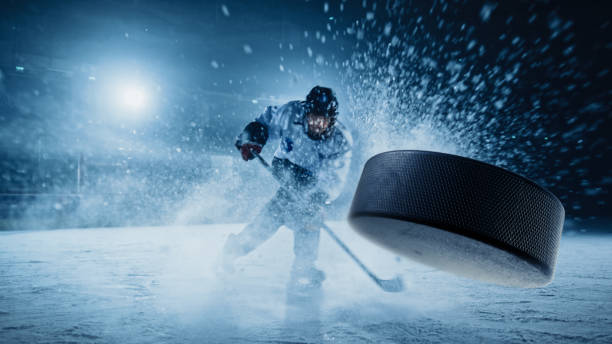
In-Store: The hands-on feel of shopping in-store is unbeatable. You get instant feedback on fit, expert tips, and the chance to compare models side by side. Just keep in mind, in-store choices might be a bit limited.
Online: Shopping online gives you a huge range and the convenience of doorstep delivery. Many websites offer detailed guides and size charts. The only catch? You can’t test it out beforehand, so the fit can be hit or miss.
When choosing where to purchase your hockey skates, understanding the distinct pros and cons of each option is key.
| Purchase Method | Advantages | Disadvantages | Best For |
|---|---|---|---|
| In-Store | Immediate fit feedback, expert advice, physical comparison | Limited variety, potentially higher prices | Skaters who prioritize fit and personal guidance |
| Online | Wider selection, convenience, often better deals | Risk of incorrect fit, reliance on size charts | Skaters looking for more options and potentially lower prices |
Hey, I’ll soon share a detailed guide on where to get the best hockey skates. Stay tuned!
2. Brands and Satisfaction Guarantees

Hockey Skate Brands like CCM and True are highly regarded for their customer-centric policies, which prioritize customer satisfaction.
They go the extra mile by offering satisfaction guarantees or free returns, which can be particularly reassuring, especially when making online purchases and ensuring the right fit. It’s always wise to review the return policy to guarantee a smooth and risk-free shopping experience.
When delving into the process of selecting the perfect pair of hockey skates, take your time to explore the diverse range of options detailed in our comprehensive guide on Hockey Skate Brands.
For a more thorough understanding of the distinguishing features of different brands, make sure not to overlook our detailed comparison between CCM and Bauer. Furthermore, to enhance your skills and maximize the performance of your new skates, be sure to check out our collection of beneficial Ice Hockey Skating Drills.
3.Highlighted Skate Series and Features:
When you’re picking out the perfect hockey skates, it’s key to know what makes each top skate series special. Each series has its own perks that suit different playing styles, helping you decide which one’s right for you. Let’s dive into these series to help you with your choice.
Bauer Vapor Series: The Bauer Vapor line stands out with its Curv Composite material, giving you precision and agility. The 3D-lasted design ensures a snug boot shape, and the thermoformed X-rib pattern provides a secure fit around your heel and ankle, perfect for players who love speed and quick moves.
CCM Tacks Series: CCM Tacks skates use carbon composite materials for strength and durability. They’re anatomically designed to fit your foot comfortably and control moisture well. Great for players who want power and stability on the ice.
Bauer Supreme Series: If you need power and stability, like defensemen and physical players, Bauer Supreme skates are your go-to. They’re built for maximum energy transfer, with a solid construction to boost your power while skating.

CCM Ribcor and Jetspeed Skates: These skates are all about agility and speed, perfect for players who make quick turns and fast moves. The Ribcor and Jetspeed lines focus on flexibility and responsiveness, keeping you nimble on the ice.
| Skate Series | Target Player | Key Features | Ideal for |
|---|---|---|---|
| Bauer Vapor | Speedy, agile players | Curv Composite material, 3D-lasted design, thermoformed X-rib pattern | Quick movements, tight turns |
| CCM Tacks | Power players, all-rounders | Carbon composite material, anatomical design, moisture control | Stability, energy transfer |
| Bauer Supreme | Defensive, physical players | Sturdy build, designed for power and energy transfer | Power skating, stability |
| CCM Ribcor | Agile, quick players | Flexibility, responsive design | Rapid movements, agility |
| CCM Jetspeed | Fast, agile players | Lightweight, acceleration-focused design | Speed, quick turns |
Budgeting and Price Ranges
A. Cost Considerations
Skates are available in a broad price range, suiting the needs of both casual players and dedicated athletes. It can be alluring to opt for cheaper skates, but it’s important to consider that affordability doesn’t always equate to the best value. When deciding on a purchase, take into account factors such as how often you’ll be using the skates, your skill level, and the potential for personal growth within the sport.
Here is a comprehensive breakdown of what you can anticipate regarding pricing and features across various tiers of hockey skates:
| Price Range | Target Audience | Expected Features | Typical Price Range |
|---|---|---|---|
| Entry-Level | Beginners, young players | Basic comfort and support, less advanced materials | $50 – $150 |
| Mid-Range | Intermediate players | Improved materials, additional features for comfort and performance | $150 – $400 |
| High-End | Advanced or professional players | Top-tier materials, cutting-edge technology, maximum durability | $400 – $1000 |
B. Investing in Quality
High-quality skates are like a solid investment for your performance and safety. They bring top-notch materials, advanced tech, and superior construction to the table, all working together to up your game and keep those injuries at bay. Sure, they might cost a bit more upfront, but their lasting durability usually pays off in the end!
Searcher Considerations
When you’re on the hunt for skates, think about things like how they fit, how comfy they are, the quality of the blades, and where your skill level’s at. It’s not just about snagging a pair of skates; it’s about finding that perfect ice buddy.
Hockey Skates Maintenance and Care
A. Routine Care
Proper maintenance is crucial for extending the life of your skates. Ensuring regular blade sharpening, tailored to your usage frequency, is essential to maintain optimal performance on the ice. After each use, make sure to thoroughly dry your skates to prevent any rust or damage.
Additionally, pay close attention to your laces for signs of wear and tear, replacing them promptly when needed.
Don’t forget to conduct periodic checks for any loose screws or damaged holders to avoid unexpected issues while skating. By following these routine maintenance guidelines diligently, you can enhance both the performance and longevity of your skates.
| Maintenance Task | Description | Frequency |
|---|---|---|
| Blade Sharpening | Keeping blades sharp for optimal performance | After every 4-6 hours of play, or when edges feel dull |
| Drying | Prevent rust and damage to the blades and boot | After every use |
| Lace Inspection | Checking laces for wear, tear, and proper fit | Monthly, or as needed |
| Screw Tightening | Ensuring all parts are securely fastened | Every few weeks, or as needed |
| Boot Cleaning | Keeping the boot clean to prevent material breakdown | As needed |
| Inspection for Damage | Checking for cracks, splits, or severe wear | Monthly, or after significant impact |
B. Replacement Signs
Be mindful of the telltale signs that your skates require replacing: persistent discomfort, reduced support affecting your performance, evident damage to the boot’s structure, or a blade sharpened to its maximum limit.
Knowing when to upgrade your skates can have a substantial influence on your overall skating experience and skill development. Recognizing these crucial indicators will help you identify the perfect time to invest in a new pair of skates and enhance your performance on the ice.
| Sign of Wear | Description |
|---|---|
| Persistent Discomfort | Skates no longer fit comfortably, even after adjustments |
| Decreased Support | Ankle or foot support is compromised, leading to instability |
| Visible Boot Damage | Cracks, splits, or severe wear in the boot material |
| Blade Limitation | Blade has been sharpened to its minimal thickness |
| Performance Decline | Noticeable decrease in performance, such as loss of speed or control |
Special Considerations
A. Skates for Children and Youth
When picking skates for young players, go for ones with adjustable sizing to fit growing feet. Make sure they give enough ankle support to avoid injuries and boost confidence on the ice. Comfort and protection should be top of mind for these young skaters.
B. Adjustments and Customizations
Custom fittings really step up your comfort and game. Heat molding, offered at lots of skate shops, customizes the fit to your foot shape. Upgrading insoles can boost arch support, and adjusting blade profiling can match your skating style and position.
Expert Answers to Your Hockey Skate Queries: Sizing, Selection, and Care
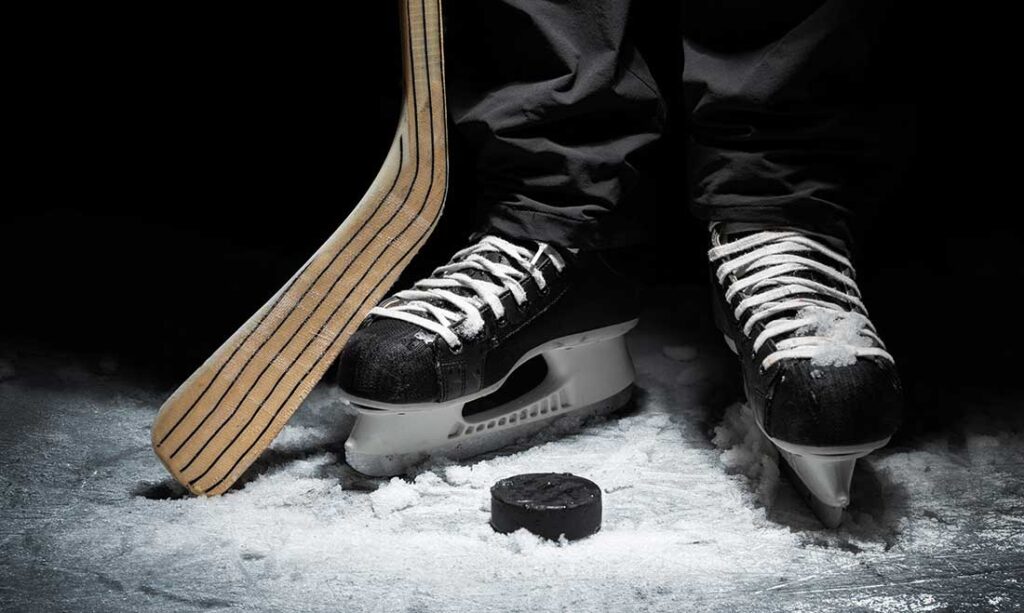
How do I choose a hockey skate?
Pick skates that fit snugly with little heel movement, providing comfort and ankle support. Think about your skill level and playing style, and choose materials and blade designs that boost your performance on the ice.
How do I know what size hockey skates I need?
Hockey helmets or hockey skate sizes usually run about 1-1.5 sizes smaller than your shoe size. To get the right fit, measure your foot and check the brand’s size chart for a snug, comfy fit.
How do I know what skates to buy?
Assess your playing frequency, skill level, and foot shape to ensure you find the perfect fit. Look for skates that not only provide comfort, support, and durability but also cater to your specific needs on the ice.
Delve into researching various brands, comparing features, and reading reviews to gain a comprehensive understanding of how different models perform and their quality standards.
This thorough approach will help you make an informed decision when selecting your ideal pair of skates.
How to buy skates for beginners?
For beginners, it’s key to go for comfort and support. Opt for skates with some flexibility to break in easily and fit comfortably. Look for good ankle support and a snug, comfy fit without being overly tight.
What are hockey skates made of?
Hockey skates are crafted from a mix of leather, synthetic materials, and carbon fiber for durability and flexibility. Their stainless steel blades provide strength and sharpness.
How much do hockey skates cost?
Hockey skates can go from around $50 for basic ones to upwards of $700 for the pro-grade models. The price changes depending on the materials, tech, and brand.
What size hockey skates should I get?
Choose a shoe size 1-1.5 sizes smaller than your regular size for a snug fit. Measure your foot length and check the brand’s size chart for accuracy.
Which hockey skates are best for my style of play?
For aggressive players looking to enhance their game, opting for stiffer skates can significantly improve energy transfer on the ice.
On the other hand, playmakers who rely on agility and quick movements may find that more flexible skates provide better maneuverability, allowing them to glide effortlessly across the rink while making precise plays.
How to buy kids’ hockey skates?
Check out skates that can be adjusted for growing feet, make sure they provide solid ankle support and comfort. And remember, durability is crucial for active young players.
Goalie skates vs. player skates
Goalie skates have flat, short blades for stability and wide boots for protection. Player skates focus on speed and agility with longer, curved blades.
Hockey skates vs. figure skates
Hockey skates have a rounded blade for agility, while figure skates feature toe picks and longer blades for jumps and spins. Find out more in our guide on Hockey Skates vs. Figure Skates.
How to bake hockey skates?
Baking skates in a skate oven at a pro shop custom molds them to your feet for a personalized fit. Just a heads up, DIY baking isn’t advised as it could damage the skates.
How (and how often) to sharpen hockey skates?
Sharpen your skates every 4-6 weeks or after about 20 hours on the ice. Keeping up with regular hockey skate sharpening helps you stay sharp and safe out there on the rink!
When to replace hockey skate blades?
Swap out blades when they get too short to sharpen or if they’re damaged. Keeping an eye out during routine checks can pinpoint the best time for a replacement.
Wrapping up our exploration of hockey skates
Fit and Size: Hey there, remember, getting the right fit is key – your skates should feel like they’re part of you.
Selection Based on Use: Go for skates that match how often you play, where you play, and your skill level.
Technology and Personalization: Get excited about the cool skate tech out there and find a pair that suits your playing style.
Purchase Wisely: Think about whether to buy in-store or online, and check out brands that offer satisfaction guarantees.
Budget Considerations: Invest in good skates that fit your budget and playing needs.
Maintenance: Keep your skates in top shape and replace them when needed for better performance and safety on the ice.
Special Needs: Look into adjustable options for kids, and go for custom fittings for the best comfort and performance.
Use this info to boost your on-ice skills, whether you’re just starting out or a seasoned player looking to up your game with the right pair of skates.
